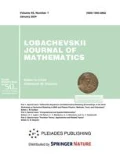Abstract
In this paper we present analytical solutions for the cantilever beam bending problems obtained in the non-classical electroelasticity theory with strain and electric field gradient effects. We show that considered model allows to provide the refined analysis for the electric field distribution around the supproted end of the cantilever taking into account the extended number of boundary conditions, which cannot be captured in classical models.


Similar content being viewed by others
REFERENCES
R. Berger et al., ‘‘Thermal analysis using a micromechanical calorimeter,’’ Appl. Phys. Lett. 69, 40–42 (1996).
H. Lang et al., ‘‘A chemical sensor based on a micromechanical cantilever array for the identification of gases and vapors,’’ Appl. Phys. A 66, S61–S64 (1998).
Y. Zhang et al., ‘‘A review on pinciples and applications of Scanning Thermal Microscopy (SThM),’’ Adv. Funct. Mater. 54, 1900892 (2019).
N. Lavrik et al., ‘‘Cantilever transducers as a platform for chemical and biological sensors,’’ Rev. Sci. Instrum. 75, 2229–2253 (2004).
M. Krommer, ‘‘On the correction of the Bernoulli–Euler beam theory for smart piezoelectric beams,’’ Smart Mater. Struct. 10, 668–680 (2001).
J. Yang, The Mechanics of Piezoelectreic Structures (World Scientific, London, 2006).
A. Elshafei and F. Alraiess, ‘‘Modeling and analysis of smart piezoelectric beams using simple higher order shear deformation theory,’’ Smart Mater. Struct. 22, 035006 (2013).
L. Landau et al., Electrodynamics of Continuous Media (Elsevier, Amsterdam, 2013).
Y. Yue et al., ‘‘Strain gradient and electric field gradient effects in piezoelectric cantilever beams,’’ J. Mech. Behavior Mater. 24, 121–127 (2015).
Y. Yue et al., ‘‘Microscale size effects on the electromechanical coupling in piezoelectric material for anti-plane problem,’’ Smart Mater. Struct. 23, 125043 (2014).
Y. Solyaev and S. Lurie, ‘‘Numerical predictions for the effective size-dependent properties of piezoelectric composites with spherical inclusions,’’ Compos. Struct. 202, 1099–1108 (2018).
Y. Solyaev and S. Lurie, ‘‘Pure bending of a piezoelectric layer in second gradient electroelasticity theory,’’ Acta Mech. 230, 4197–4211 (2019).
S. Lurie and Y. Solyaev, ‘‘Anti-plane inclusion problem in the second gradient electroelasticity theory,’’ Int. J. Eng. Sci. 144, 103129 (2019).
D. Iesan, ‘‘A theory of thermopiezoelectricity with strain gradient and electric field gradient effects,’’ Eur. J. Mech. A 67, 280–290 (2018).
S. Lurie and Y. Solyaev, ‘‘On the formulation of elastic and electroelastic gradient beam theories,’’ Continuum Mech. Thermodyn. 31, 1601–1613 (2019).
S. Lurie and Y. Solyaev, ‘‘Revisiting bending theories of elastic gradient beams,’’ Int. J. Eng. Sci. 126, 1–21 (2018).
R. Mindlin, ‘‘Micro-structure in linear elasticity,’’ Arch. Ration. Mech. Anal. 16, 51–78 (1964).
R. Maranganti and P. Sharma, ‘‘A novel atomistic approach to determine strain-gradient elasticity constants: Tabulation and comparison for various metals, semiconductors, silica, polymers and the (Ir) relevance for nanotechnologies,’’ J. Mech. Phys. Solids 55, 1823–1852 (2007).
F. Dell’Isola et al., ‘‘Pantographic metamaterials: An example of mathematically driven design and of its technological challenges,’’ Continuum Mech. Thermodyn. 31, 851–884 (2019).
V. Eremeyev et al., ‘‘Flexoelectricity and apparent piezoelectricity of a pantographic micro-bar,’’ Int. J. Eng. Sci. 149, 103213 (2020).
E. Lomakin et al., ‘‘Refined stress analysis in applied elasticity problems accounting for gradient effects,’’ Dokl. Phys. 64, 482–486 (2019).
Funding
This work was partially supported by the Russian Foundation for Basic Research (project nos. 18-08-00643 and 18-01-00553) and President Grant MK-2856.2019.8.
Author information
Authors and Affiliations
Corresponding authors
Additional information
(Submitted by A. V. Lapin)
Rights and permissions
About this article
Cite this article
Solyaev, Y., Ustenko, A. & Lykosova, E. Refined Analysis of Piezoelectric Microcantilevers in Gradient Electroelasticity Theory. Lobachevskii J Math 41, 2076–2082 (2020). https://doi.org/10.1134/S1995080220100157
Received:
Revised:
Accepted:
Published:
Issue Date:
DOI: https://doi.org/10.1134/S1995080220100157



